Although we liked the Sony Bravia W4000 LCD series we tested back in May 2008, we bemoaned the lack of 100Hz technology, user menu white balance control, and proper film mode deinterlacing. The Sony KDL40W4500 LCD TV is blessed with 100Hz Motionflow technology, but does it address the other deficiencies? Let’s find out in today’s review.
<!-- google_ad_client = 'pub-2887677957235196'; google_ad_slot = '4990177225'; google_ad_width = 336; google_ad_height = 280; //-->
Note: The specific model we tested was the Sony KDL40W4500U (which denotes the 3-pin-plug United Kingdom version), but the terms KDL40W4500 and KDL40W4500U will be used interchangeably throughout this review. Also, this model has been discontinued, and has been replaced by the new Sony Bravia EX503 series KDL40EX503U.
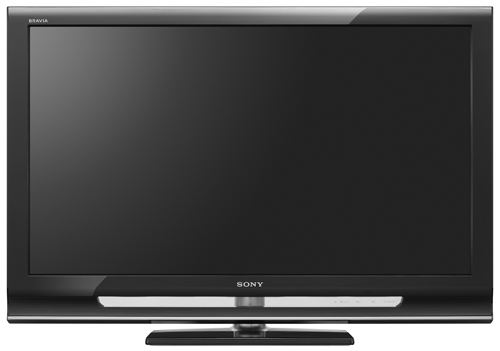
Just like the W4000, the Sony KDL40W4500 HDTV sports a transparent segment of perspex between the slightly glossy LCD screen and the finely perforated speaker grille. The bezel and (to a lesser extent) the speaker grille are finished in polished black; and the ensemble is underlined by a thin silver strip spanning the entire width of the frame. Whilst not as slim as some of the latest offerings from rival manufacturers, the KDL40W4500 manifests solid build quality and a touch of stylistic sophistication – check out the embedded LED indicators on the glass-like perspex, and the illuminated logo – that has Sony written all over it.
The Sony KDL40W4500 LCD television only has 3 rather than the now-commonplace 4 HDMI inputs, but compensates by offering these additional multimedia interfaces:
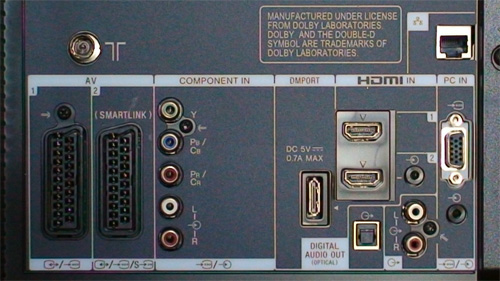 |
| Rear: 2 x HDMI, VGA, component, 2 x Scarts, aerial, LAN port, DM port, audio outs |
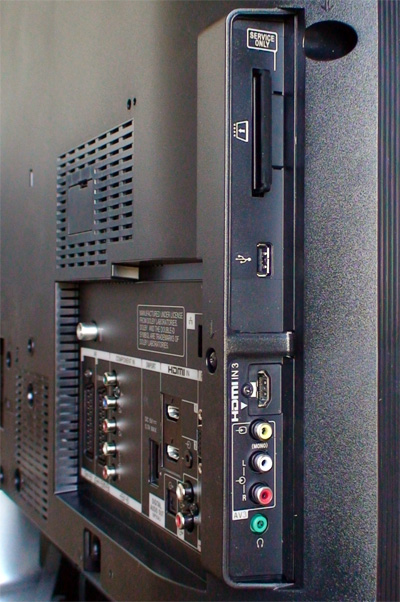 |
| CI slot, USB, HDMI, composite video, headphone |
The XMB-driven user menu on the Sony KDL40W4500 is essentially unchanged from that on the W4000, except for the inclusion of [Motionflow] and [Game/Text Mode] options in the [Features] submenu:
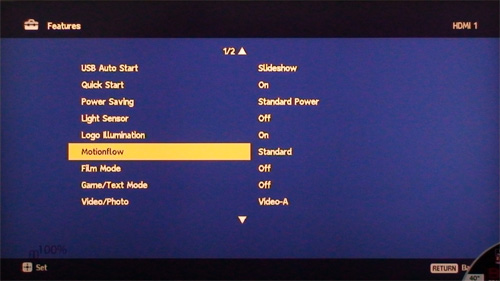
In addition to the decidedly bland but functional Sony EPG we’ve previously witnessed on the W3000 and W4000, the Sony KDL40W4500 also provides an alternative version powered by Guide Plus+ which takes about 30 minutes to set up for the first time.
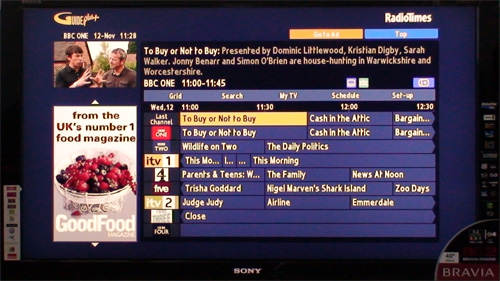
Even though the Guide Plus+ version looks more attractive due in no small part to a small window crisply displaying the current channel (shame about the separate advertisement column beneath it though), there is a slight delay between pressing the [Guide] button on the remote and the Guide Plus+ listings appearing on screen, so more often than not we found ourselves reverting to the standard Sony EPG for daily use.
Sleek and responsive, the Sony KDL40W4500’s remote control is the same as those bundled with the W4000 and V4000 LCD TVs we’ve reviewed recently. In terms of background noise, the Sony KDL40W4500 emitted a soft low-pitched hum from the rear of the panel especially when there’s content on screen. Viewers with sensitive hearing may find this distracting at night or during quiet scenes, but sitting 6 feet from the television with normal TV volume, we were never troubled by the hum.
Disappointingly, there remains no white balance control (which would have helped tremendously in greyscale calibration to D65 standard) in the user menu of the Sony KDL40W4500 HDTV. As things stood, we had to make do with one of their [Colour Temperature] presets, of which “Warm 2” came closest to D65:
 |
| [Colour Temp] “Warm 2” CCT |
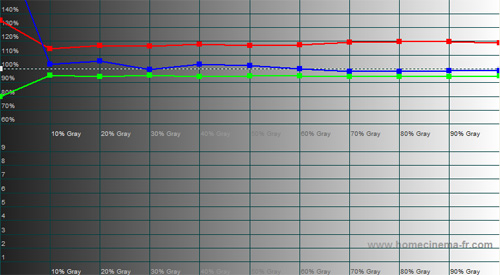 |
| [Colour Temp] “Warm 2” RGB Tracking |
Even for someone who’s used to D65 images, the resultant picture may look too warm/ yellow/ red. There is certainly a case for setting [Colour Temp] to “Warm 1“: although “Warm 1” deviates even further from D65 than “Warm 2“, the picture may actually be more tolerable to the uninitiated because of its bluer (and hence brighter) cast.
 |
| [Colour Temp] “Warm 1” CCT |
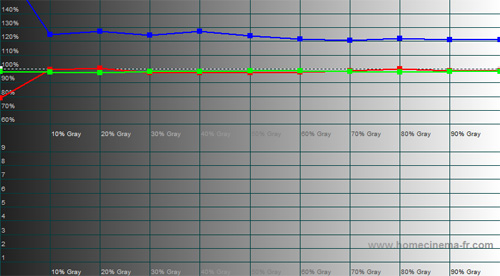 |
| [Colour Temp] “Warm 1” RGB Tracking |
“Colour Like No Other“… we’ve always been impressed with the colour accuracy on Sony’s high-end Bravia LCD televisions (i.e. W and X series), and the Sony KDL40W4500 continues this fine tradition. With [Colour Space] set to “Standard“, the primary colour points were as close as they come – remember this is achieved out-of-the-box without any colour management system (CMS) available – to HD Rec. 709 specifications:
![[Colour Space] Standard](https://www.hdtvtest.co.uk/news/wp-content/uploads/2018/04/hdtv_Sony-KDL40W4500_cie.jpg) |
| [Colour Space] “Standard” CIE chart with reference to HD Rec. 709 |
Because the [Hue] control is greyed out unless the KDL40W4500 receives an NTSC video signal, we were not able to align the slightly-off yellow and magenta secondary colour points. Who knows… had Sony included white balance controls in the user menu, the secondary colours would probably fall nicely into place once we calibrate greyscale to D65.
![[Colour Space] Wide](https://www.hdtvtest.co.uk/news/wp-content/uploads/2018/04/hdtv_Sony-KDL40W4500_cie-cs-wide.jpg) | ![[Live Colour] High](https://www.hdtvtest.co.uk/news/wp-content/uploads/2018/04/hdtv_Sony-KDL40W4500_cie-live-colour-high.jpg) |
| [Colour Space] “Wide” CIE | [Live Colour] “High” CIE |
[Colour Space] “Wide” led to an oversaturated colour gamut (green in particular); escalating the level of [Live Colour] would progressively exaggerate the colour inaccuracies.
| Dead pixels | None |
| Screen uniformity | Clouding and backlight bleed reducible to negligible levels |
| Overscanning on HDMI | 0% with [Display Area] set to “Full Pixel“ |
| Blacker than black | Passed |
| Black level | Excellent (0.05 cd/m2 calibrated) |
| Black level retention | Stable |
| Primary chromaticity | Excellent with [Colour Space] “Standard“ |
| Scaling | Above average |
| Video mode deinterlacing | Average; limited jaggies reduction |
| Film mode deinterlacing | Poor; Failed 3:2/ 2:2 cadences in 480i/ 576i |
| Viewing angle | Good for an LCD TV (90°) |
| Motion resolution | 650 with [Motionflow] engaged; 300 otherwise |
| Digital noise reduction | Acceptable at baseline |
| Sharpness | Undefeatable edge enhancement on 1080i/1080p |
| 1080p/24 capability (PS3) | Accepts 1080p/24 video signal; no telecine judder |
| Input lag | 0-10ms in [Game Mode] or over VGA; 30-50ms otherwise |
| Default ([Picture Mode] “Standard“) | 172 watts |
| Calibrated ([Picture Mode] “Cinema“) | 90 watts |
| Standby | 14 watts with [Quick Start] engaged; <1 watt otherwise |
Out-of-the-box, we witnessed an alarming amount of patchy unevenness (“clouding”), and backlight bleed on the top left and bottom right of the LCD screen when watching very dark scenes on the Sony KDL40W4500 in a dimly-lit viewing environment. However, proper calibration (hint: set [Backlight] to “Min“) attenuated these to negligible levels… only the harshest critics would still complain about the remaining trace of backlight bleed at the top left corner, and lightness at the sides of the screen.
Irrespective of whether the Sony KDL40W4500 was calibrated or not, off-axis viewing aggravated the screen/ backlight uniformity issues on top of the usual black level, contrast and colour washout typical of LCD screens. If you’re looking for a HDTV that delivers near-perfect screen uniformity with wide viewing angles, plasma is the way to go.
The video processing qualities of Sony’s Bravia Engine have always left us a bit underwhelmed, and unfortunately the KDL40W4500 fared no better in this regard. While standard-def upscaling was above average, video mode deinterlacing remained mediocre with almost no smoothening of jagged edges in the rotating wheel, bouncing bars and waving flag tests.
Film mode deinterlacing was similarly poor on the Sony KDL40W4500 LCD HDTV. Even with [Film Mode] engaged, the Sony KDL40W4500 took quite a long time to detect (and, once detected, struggled to keep a lock on) 3:2 cadence over 480i. Perhaps more relevant for UK and European users, the Sony KDL40W4500 failed to detect and process 2:2 cadence over 576i. The only consolation was that the KDL40W4500 was able to deinterlace correctly film-based 1080i content with [Film Mode] engaged.
Given the television’s ability to deliver excellent black-level performance and accurate colour palette, Iron Man on Blu-ray looked fantastic on the Sony KDL40W4500. To our surprise, the absence of D65 greyscale didn’t really detract from the eye-popping movie viewing experience all that much (even during the well-shot daylight scenes)… the vibrant yet natural colours and the penetrating sense of depth and dimensionality more than made up for the slightly warmer colour temperature.
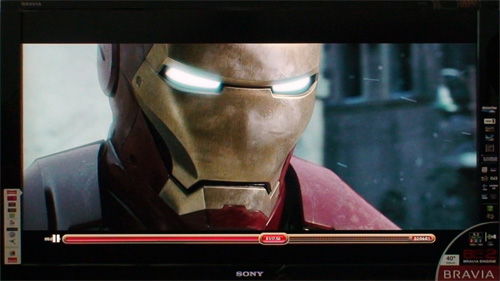
With [Display Area] set to “Full Pixel” to achieve 1:1 pixel mapping with zero overscan, the Sony KDL40W4500 HDTV extracted and presented the fine details inside the movie – for example the grains of sand in the Afghanistan desert and the sophisticated intricacies of Iron Man’s armour – with exquisite clarity. Up-close, the film grain (which creates a grittier and more realistic atmosphere) during the opening desert scenes did appear a tad harsh on our eyes due to a small trace of undefeatable edge enhancement, but from a sensible viewing distance of 6 feet away this never posed any problems. Of course, we would have preferred it if Sony had allowed us to do away with even the slightest hint of excessive sharpening, especially when it comes to absolutely pristine 1080p signals that need no further enhancement.
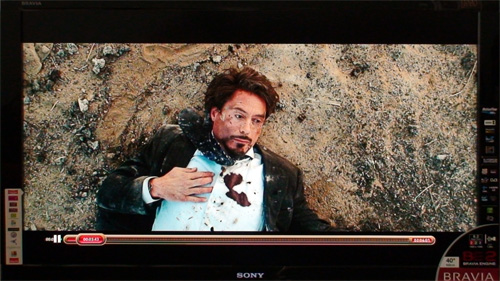
As we’ve come to expect from the latest Sony Bravia LCD TVs, the KDL40W4500 handled 1080p/24 video signal from the PS3 beautifully without exhibiting any sign of telecine judder, as evidenced by the smooth-as-butter pan when the camera pulled away from the ravishing reporter inside Tony Stark’s (Robert Downey Jr.) living lounge to reveal his luxurious mansion perched on the edge of a cliff overlooking the Pacific Ocean at around the 00:09:20 mark.
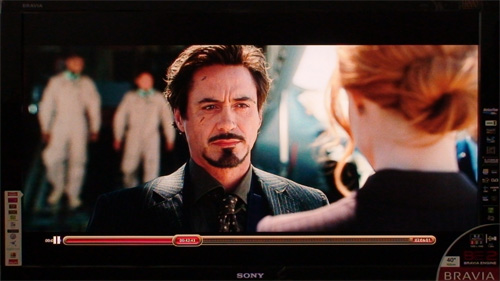
Engaging Sony’s [Motionflow] 100Hz technology did introduce a whiff of video-like flavour to the original 24p filmic quality of Iron Man, but it’s certainly the least offensive among all the motion-compensated frame interpolation (MCFI) implementations we’ve seen on LCD televisions to date. To its credit, [Motionflow] indeed reduces motion blurring: as the camera tracked Tony Stark’s limousine at the beginning of Chapter 6, the “YF-22” label on the fighter jet model and the definition of the clapping crowd were simply clearer with [Motionflow] on than off.
The motion resolution benefit of [Motionflow] extended to standard-definition content as well, particularly fast-action sports like the Carling Cup football highlights on ITV1. And the good news is, interpolation artefacts (that used to plague older 100Hz technologies) were few and far between, limited to the odd shimmers around moving players which could easily be overshadowed by mosquitoe noise inherent in highly compressed video anyway.
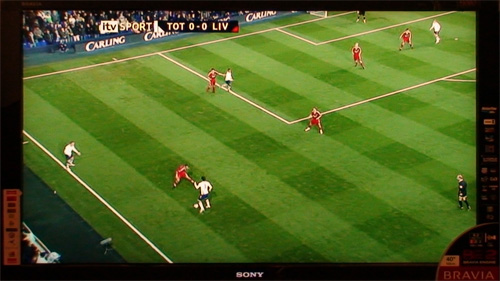
Despite its subpar video and film mode deinterlacing, the Sony KDL40W4500 delivered quite an alluring SD image thanks to its above average scaling, deep blacks and realistic colours. Just make sure that both [Noise Reduction] and [MPEG Noise Reduction] are disabled, as they tend to blur the picture detail and introduce motion smearing.
There’s a valid reason why Sony included a [Game/Text Mode] on the KDL40W4500 (there was none on the W4000): according to our measurements, engaging [Game/Text Mode] on the Sony KDL40W4500 reduced input lag from typically 30-50ms (whether [Motionflow] was engaged or not doesn’t make a difference) to 0-10ms.
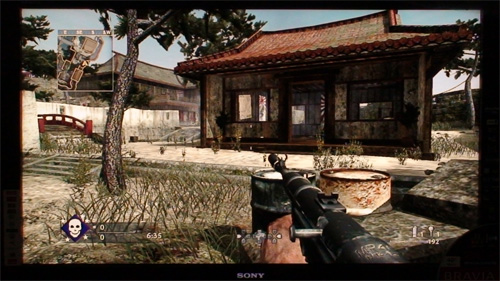
So while we were enthralled by how the Sony KDL40W4500 portrayed the phenomenal detail, texture and lighting effects in Call Of Duty 5: World At War, it was the almost lagless gaming response that helped us rake in the points and climb up the ranks in online play.
The Sony KDL40W4500 is the logical next step up from the W4000 series, adding a functional 100Hz MCFI system to excellent blacks, accurate colour gamut and almost no input lag (with the appropriate configuration). Had Sony offered white balance controls in the user menu, implemented better video and film mode deinterlacing, and got rid of the undefeatable edge enhancement however slight, the KDL40W4500 could have been a potential world beater (though it’s not inconceivable that Sony are reserving the best features for their flagship X4500 range). Nevertheless, these relatively innocuous flaws do not stop the Sony KDL40W4500 from being one of the best LCD HDTV in its price class.

<!-- google_ad_client = 'pub-2887677957235196'; google_ad_slot = '0693194791'; google_ad_width = 336; google_ad_height = 280; //-->